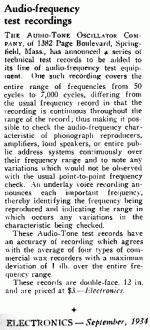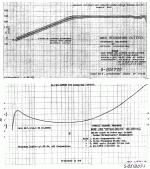Not particularly but an accurate IIR for RIAA requires a little trickery itself at low sampling rates especially if you are trying to bother with the 50k time constant.
Even if there were such a thing as a 50K time constant, which there isn't, nothing approaching 50k is above the noise floor on a record. I've been cutting lacquers a long time and worrying about anything above 15k is useless. It ain't going on the record.
The mythical 50K time constant is equivalent to the LPF after the RIAA in the SE66 I linked to.
Even if there were such a thing as a 50K time constant, which there isn't, nothing approaching 50k is above the noise floor on a record.
Never said there was, someone asks for something and you help them out if you can. The minimum phase FIR is +-2 micro-dB and +-10 micro-degrees over the entire audio range, it doesn't matter but if your DSP can do it some want to.
You could maybe help out on the DIY test LP tread (stalled again) BTW. There is an old CBS STR series test LP for testing the old quadraphonic cartridges that has some tracks that are behaved well beyond 20k
You could maybe help out on the DIY test LP tread (stalled again) BTW. There is an old CBS STR series test LP for testing the old quadraphonic cartridges that has some tracks that are behaved well beyond 20k
Making a good test record is the most difficult thing you could possibly cut. Doing one to rigorous technical specifications is a ton of work. Like a PHD thesis type project.
I have incomplete documentation of a Buchmann Meyer measurement system that was an in-house Ortofon system. You could also measure with an electron microscope is you want any kind of accuracy above 10k.
That's a retirement project for me. A friend has an idea for another measurement method but i can't really talk about that.
I have a NOS Panasononic CD4 system with the test record. It's never been used. I also have just about every test record under the sun. I also own the Shure lathe that was used to make the Shure test records. Those were not done to the accuracy I would want but were fine for cart setup and general parameters.
Making a good test record is the most difficult thing you could possibly cut. Doing one to rigorous technical specifications is a ton of work. Like a PHD thesis type project.
We're not looking for rocket science here and certainly not NIST traceable results. Most members are interested in the basic cartridge alignment, TT speed stability, etc. on an at cost basis (something like $15 post paid). Others want to include (because there might be space) some more researchy tracks.
We have already endured some serious personal "impedance mismatches" in this process for various reasons and have not progressed. One reason is some of the tracks are best done with all equalization removed which has proven not to appeal to the small run LP houses. You should also realize there are people here with deep knowledge of signal processing and how things work in general. It would be nice if you could contribute in a DIY do it for fun and keep the brain functioning way, i.e. this is an open source project.
Last edited:
It would be nice if you could contribute in a DIY do it for fun and keep the brain functioning way, i.e. this is an open source project.
I'm willing to help. Is there a thread I could check out to see what the general parameters of what everyone wants?
I can contribute some reasonable amount of time and lacquers. I would't want to be the guy who is stuffing the envelopes or doing the production run.
For accurate level calibration Flo Kaufman's test record is probably the best currently available.
flokason best audio blog – latest news out of the lab – news and other important information
Last edited:
I'm willing to help. Is there a thread I could check out to see what the general parameters of what everyone wants?
I can contribute some reasonable amount of time and lacquers. I would't want to be the guy who is stuffing the envelopes or doing the production run.
For accurate level calibration
No problem, I'll give the guys a heads up.
I know this is OT but what are some practical reasons you would want to use an FIR minimum phase filter instead of a plain old IIR?
AIUI, the phase implications arising out of a 'plain old IIR' filter gave rise to the FIR camp - who say because they are minimum phase ... they must be better!
I was told by someone who is much more knowledgable than I am, about such things, that FIR filters have some negatives too - so it's not straightforward!
Andy
@ Gold, dont want to drive it further off topic but it jiggles my fingers 
FIR is not by default linearphase. It is the only one that can do linearphase if you design it like that.
Its as right as saying cars can only drive 100 speed. They can drive any speed you make it drive. But if something drives 100 its most likely a car (not a bycicle).
So, using weird tools that fail being customizable, may create prejudice.
FIR has only very few "musts". It must be computed, using a convolver, must be digital. Thats all. Nothing further is a must.
josh
PS: check this tool, literally does only what you ask it to do:
FIR DESIGNER - Audio FIR filter design tool for speakers | Eclipse Audio
FIR is not by default linearphase. It is the only one that can do linearphase if you design it like that.
Its as right as saying cars can only drive 100 speed. They can drive any speed you make it drive. But if something drives 100 its most likely a car (not a bycicle).
So, using weird tools that fail being customizable, may create prejudice.
FIR has only very few "musts". It must be computed, using a convolver, must be digital. Thats all. Nothing further is a must.
josh
PS: check this tool, literally does only what you ask it to do:
FIR DESIGNER - Audio FIR filter design tool for speakers | Eclipse Audio
I think I understand now. If a filter is linear phase it must be FIR. If a filter is minimum phase it could be FIR or IIR. Is that correct? I have no dog in the race.
There are ways to make IIR's approximate (with limitations) linear phase behavior but I doubt there are tools or hardware out there for audio applications. If you have a file on a disk you can run an IIR forward and backward and get exact linear phase behavior again certainly not practical (also only good for filters with poles and zeros in matched pairs).
I'm not interested in these controversies (especially the speaker crossover stuff), it's a mathematical exercise plain and simple.
Hi Dominick,
The only way to do that safely would be at half speed. I’m not set up to do that so I can’t help you.
What about using an existing frequency sweep on a record and modifying a turntable to play at the speed that gives you the frequency range you need? It would need to be done in two ranges but I think that would work. At least for frequency response. I don’t think tracking at 50k is an issue.
The only way to do that safely would be at half speed. I’m not set up to do that so I can’t help you.
What about using an existing frequency sweep on a record and modifying a turntable to play at the speed that gives you the frequency range you need? It would need to be done in two ranges but I think that would work. At least for frequency response. I don’t think tracking at 50k is an issue.
Im interested because I make the cartridge, and even though it is not necessary it would be interesting to see haw good something is you have made. Most peoples systems do not go anywhere near 20htz or 25k, but I believe there is information there that vinyl can reproduce and adds to the existing heard frequencies. I have quite a few test records from both CBS and JVC, but not one that will do the whole job in one play. Wishful thinking I suppose lol
....RIAA accuracy of common record lathes? I would not be shocked to see fairly gross errors.
Just found this. In 1934, test-records were offered covering 50cps to 7,000cps with maximum deviation of 1db (from some average of commercial recorders).
We give them a pass on the upper octave because it is hard to cut at 78rpm, and in shellac playback you don't want another octave of noise.
That's pretty un-gross error.
Attachments
Originally Posted by davidsrsb> ....RIAA accuracy of common record lathes? I would not be shocked to see fairly gross errors.
RCA's in-house notebooks from 1940 have come to light.
Index of /schematics/RCA/RecEng/ 45 MB PDF
Recorders were tested (optical wax patterns) weekly, and monthly, and rotated back to Camden for checking every 6 months or on suspicion.
The cutter had an intrinsic bass-rise due to stiffness, which is very reliable and smooth. This is the origin of our 500Hz corner (not yet standardized). Then it runs flat to >6kHz, with minor damped resonance above.
The cutting amplifier supplied the ~~2kHz corner. This plot includes much of the system with multiple low-poles. In most complete setups the 50Hz bump would be milder.
RCA's in-house notebooks from 1940 have come to light.
Index of /schematics/RCA/RecEng/ 45 MB PDF
Recorders were tested (optical wax patterns) weekly, and monthly, and rotated back to Camden for checking every 6 months or on suspicion.
The cutter had an intrinsic bass-rise due to stiffness, which is very reliable and smooth. This is the origin of our 500Hz corner (not yet standardized). Then it runs flat to >6kHz, with minor damped resonance above.
The cutting amplifier supplied the ~~2kHz corner. This plot includes much of the system with multiple low-poles. In most complete setups the 50Hz bump would be milder.
Attachments
- Status
- This old topic is closed. If you want to reopen this topic, contact a moderator using the "Report Post" button.
- Home
- Source & Line
- Analogue Source
- RIAA Response question

